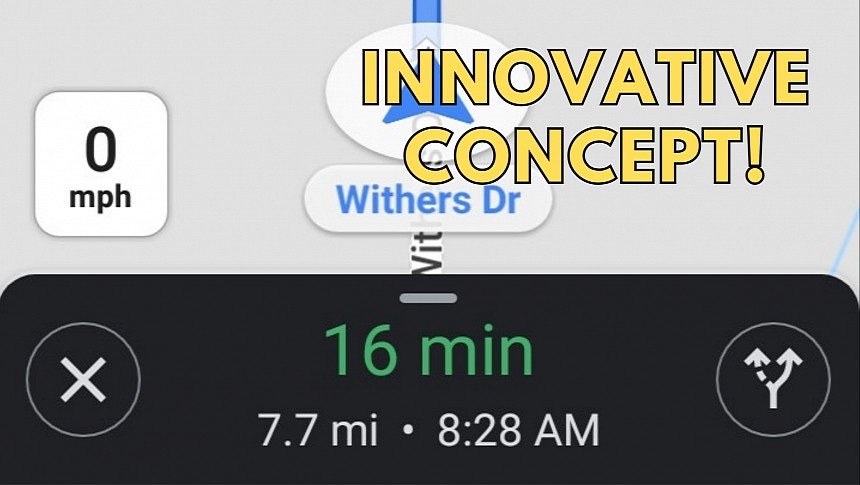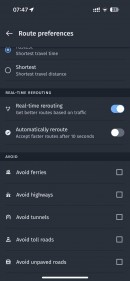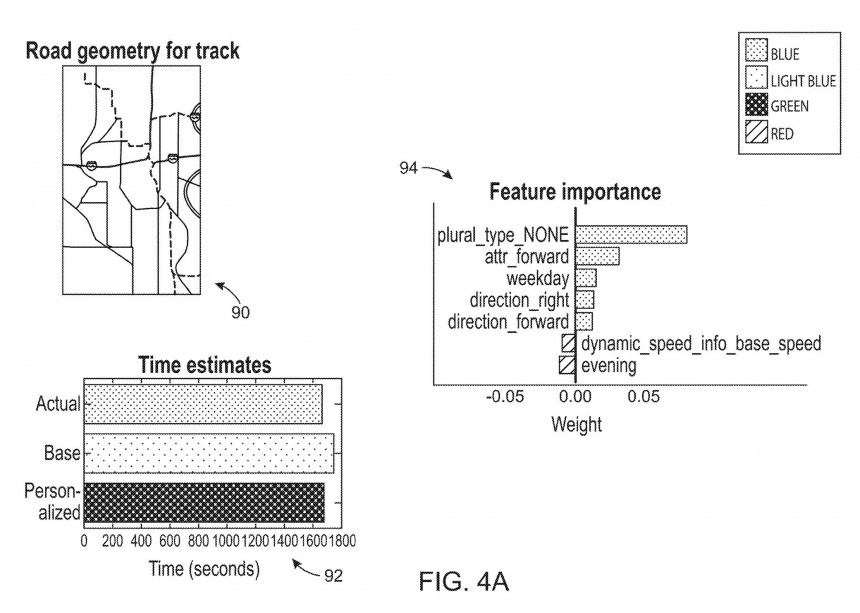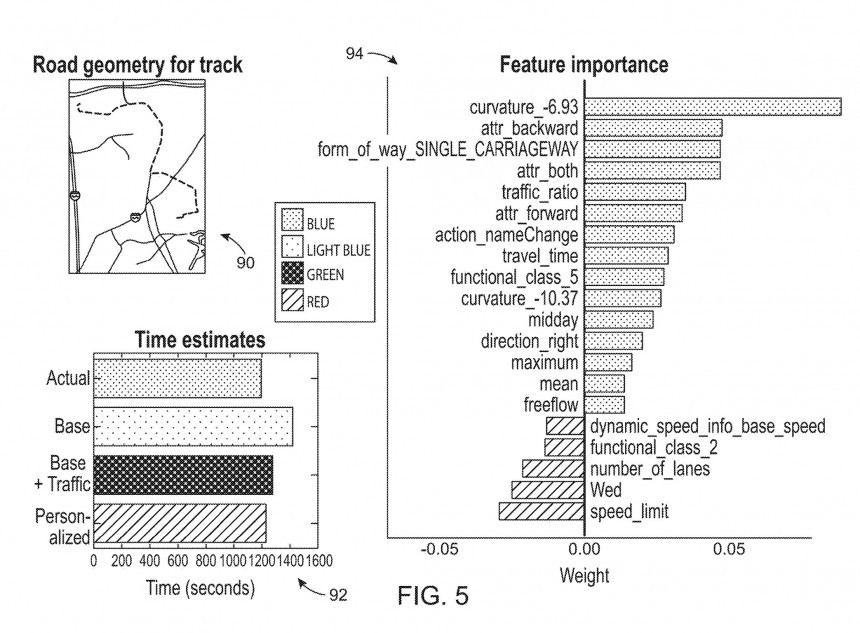Navigation software like Google Maps, Waze, and Apple Maps generate the estimated time of arrival, also known as ETA, using essential factors, including the distance to the destination, traffic conditions, and the maximum speed allowed for each road sector.
The ETA isn't always spot-on, but this is why it's called "estimated" in the first place. Applications like Waze typically offer more accurate ETAs, mainly because they rely on crowdsourced data for traffic information, so they know precisely what happens along a route and the slowdowns produced by the reported incidents.
Navigation specialist HERE proposes a new approach that could completely overhaul the concept of ETAs in cars.
A patent called "private and personalized estimation of travel time" describes a system that uses the collected data to provide personalized ETAs based on each driver's habits.
In other words, you're getting an ETA that no longer relies exclusively on a standard set of factors but also on your driving style and how you react when dealing with certain driving conditions. Eventually, the navigation app will offer a more accurate ETA different from another driver's.
HERE discusses the biggest shortcoming of ETAs in the patent, explaining that slower or inexperienced drivers need more time to execute certain maneuvers. The company also has accurate data pointing to a driver's habit's impact on the ETA, estimating that an inexperienced driver might need up to 15 percent more time to arrive at a destination, depending on traffic conditions.
The navigation expert says the navigation software must first monitor each person's driving style and habits behind the wheel. For example, if you drive significantly slower during rainy conditions, the application can collect this data and use it for further calculation of ETAs. The navigation software can check the weather forecast, and if you're expected to encounter rain along the route, it can update the ETA according.
A similar process can be used for any other difference your driving style can create. One example is how we react when driving on unfamiliar roads, especially during long journeys. Inexperienced drivers slow down mainly because they need more time to read the road signs and slow down, whereas people with more experience behind the wheel do this faster. As a result, the ETAs should be different, and this is where HERE's technology comes into play.
The application can create a profile for each driver and then use the data to calculate a more accurate ETA. The system can begin by providing personalized ETAs for roads you use more often, especially as it can collect more information, compare it against the standard ETAs, and then see how your driving style impacts the arrival time. For example, the daily commute, where HERE's software can compare higher data sets, would eventually offer more accurate ETAs simply because the application knows precisely how you drive on each road sector.
Without a doubt, privacy advocates wouldn't be very happy to hear that HERE's software keeps an eye on what drivers do and monitor their behavior on the road. However, HERE explains that it wouldn't collect data on road names and locations, as the technology wouldn't use geographic information. The system works "by classifying roads based on the characteristics of each stretch of road and not by geographic location or name."
As a result, the application wouldn't collect data related to a specific road but to a specific type of road. Furthermore, this data helps it calculate personalized ETAs for other routes where certain road sectors correspond with the information already stored in the database.
HERE also says driving data, habits, and style would never leave the mobile device. The processing would take place on a server, but all the data for calculating a personalized ETA stays on the mobile device. The software uses the driver profile to calculate a personalized ETA and then sends the difference from a standard ETA to a server. Only the correction values leave the mobile device for additional processing on a remote server.
The personalized estimated time of arrival includes heavy data processing that involves each maneuver for every little road sector. The system must know how you behave on every stretch of the route, so by putting all the data together, it eventually knows when you're expected to arrive at the destination.
The ETA might still not be 100 percent accurate because every journey is different. You might come across different traffic conditions or behave differently depending on what you encounter on the road.
HERE's technology is currently in the patent stage, but it would certainly make sense in a future navigation app where more driving data can be collected. Additionally, the necessary information can be collected automatically if HERE has access to driving information and other vehicle-related data (such as on Android Automotive, where navigation apps can read more information directly from the car's systems).
Navigation specialist HERE proposes a new approach that could completely overhaul the concept of ETAs in cars.
A patent called "private and personalized estimation of travel time" describes a system that uses the collected data to provide personalized ETAs based on each driver's habits.
In other words, you're getting an ETA that no longer relies exclusively on a standard set of factors but also on your driving style and how you react when dealing with certain driving conditions. Eventually, the navigation app will offer a more accurate ETA different from another driver's.
HERE discusses the biggest shortcoming of ETAs in the patent, explaining that slower or inexperienced drivers need more time to execute certain maneuvers. The company also has accurate data pointing to a driver's habit's impact on the ETA, estimating that an inexperienced driver might need up to 15 percent more time to arrive at a destination, depending on traffic conditions.
The navigation expert says the navigation software must first monitor each person's driving style and habits behind the wheel. For example, if you drive significantly slower during rainy conditions, the application can collect this data and use it for further calculation of ETAs. The navigation software can check the weather forecast, and if you're expected to encounter rain along the route, it can update the ETA according.
The application can create a profile for each driver and then use the data to calculate a more accurate ETA. The system can begin by providing personalized ETAs for roads you use more often, especially as it can collect more information, compare it against the standard ETAs, and then see how your driving style impacts the arrival time. For example, the daily commute, where HERE's software can compare higher data sets, would eventually offer more accurate ETAs simply because the application knows precisely how you drive on each road sector.
Without a doubt, privacy advocates wouldn't be very happy to hear that HERE's software keeps an eye on what drivers do and monitor their behavior on the road. However, HERE explains that it wouldn't collect data on road names and locations, as the technology wouldn't use geographic information. The system works "by classifying roads based on the characteristics of each stretch of road and not by geographic location or name."
As a result, the application wouldn't collect data related to a specific road but to a specific type of road. Furthermore, this data helps it calculate personalized ETAs for other routes where certain road sectors correspond with the information already stored in the database.
The personalized estimated time of arrival includes heavy data processing that involves each maneuver for every little road sector. The system must know how you behave on every stretch of the route, so by putting all the data together, it eventually knows when you're expected to arrive at the destination.
The ETA might still not be 100 percent accurate because every journey is different. You might come across different traffic conditions or behave differently depending on what you encounter on the road.
HERE's technology is currently in the patent stage, but it would certainly make sense in a future navigation app where more driving data can be collected. Additionally, the necessary information can be collected automatically if HERE has access to driving information and other vehicle-related data (such as on Android Automotive, where navigation apps can read more information directly from the car's systems).










